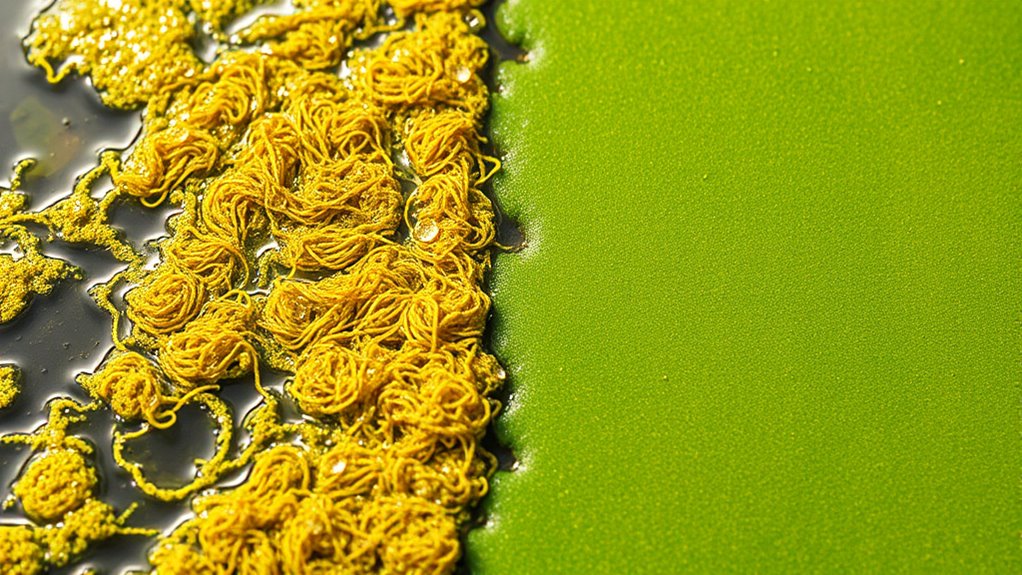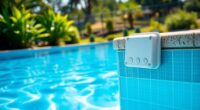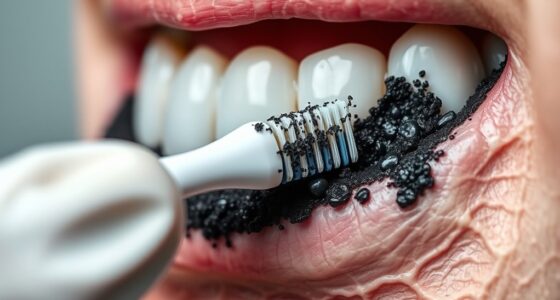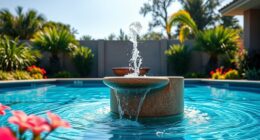To tell mustard algae from green algae, look at the color and texture. Mustard algae appears as yellow-brown patches with a slimy, waxy feel, often in shaded areas like pond walls. Green algae is bright or dark green, forming fuzzy mats and growing in sunny, nutrient-rich spots. Knowing these clues helps you identify the cause and fix the problem effectively. Keep going to discover how to treat and prevent these algae from returning.
Key Takeaways
- Mustard algae appears as yellowish-brown patches with a slimy, gelatinous texture, while green algae form vibrant, fuzzy green mats.
- Mustard algae thrives in shaded, low-light, alkaline environments; green algae prefers sunny, nutrient-rich, stagnant water.
- Mustard algae is resistant to standard treatments, requiring prolonged or specialized sanitization; green algae responds well to chlorination and brushing.
- Spot mustard algae in hard-to-reach areas like pond walls and submerged rocks; green algae often covers pool surfaces, floors, and open water zones.
- Prevent algae growth by maintaining balanced chemical levels, proper circulation, and regular cleaning; persistent outbreaks may need professional intervention.
Visual Differences Between Mustard and Green Algae

Mustard algae and green algae can often be distinguished by their distinct colors and appearances. Mustard algae typically have a yellowish-brown or tan hue, giving your pool or pond a murky, muddy look. It often appears as a thin, slimy film on surfaces, and you might notice it more in shaded areas or where water circulation is poor. Green algae, on the other hand, are bright or dark green, forming thick, fuzzy mats or clumps on surfaces. They tend to grow rapidly in warm, nutrient-rich water, creating a more vibrant, lush appearance. By observing these color differences, you can quickly identify which type of algae is present. Recognizing these visual cues helps you determine the best treatment approach for your water system. Understanding the types of algae can also help tailor your cleaning and chemical strategies for more effective control.
Color and Texture Clues to Identify Algae Types

The color and texture of algae provide clear clues to identify their type. Mustard algae typically has a slimy, yellow-green appearance with a soft, gelatinous texture that often feels sticky or mucilaginous. Its coloration is vivid and stands out against clearer water. Green algae, on the other hand, usually appears as dense, fuzzy patches or filaments, with a more matte, dull green shade. Its texture can be rough or velvety, sometimes forming slimy mats that cling tightly to surfaces. By observing these characteristics, you can distinguish between the two: vibrant yellow-green, slimy, and gelatinous for mustard algae, versus duller green, fuzzy, or velvety for green algae. Recognizing these clues helps you decide on the appropriate treatment to fix the problem effectively. Color and texture are crucial factors in accurately diagnosing algae types.
Common Locations and Growth Patterns in Ponds
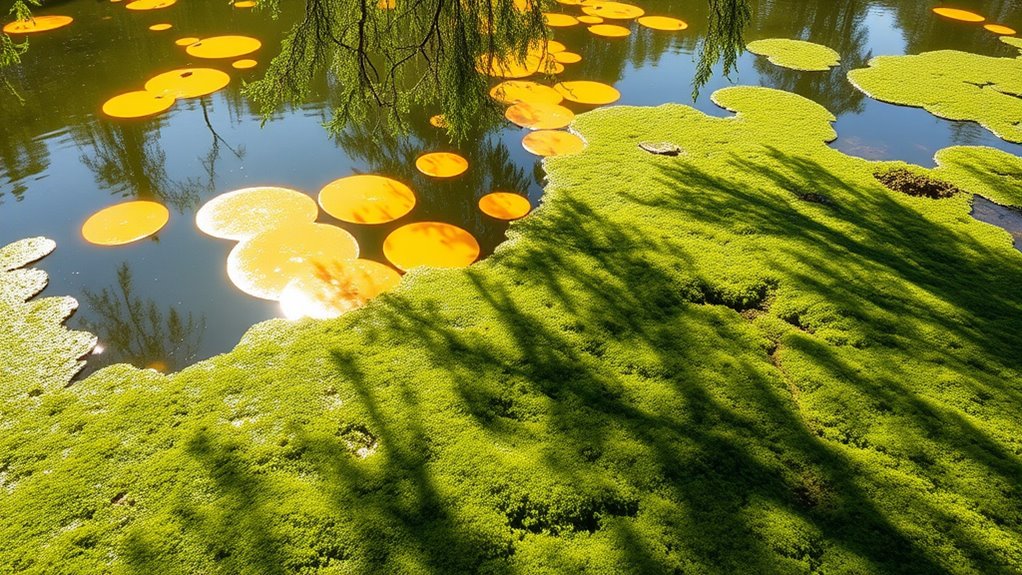
Algae tend to grow in specific areas of ponds where conditions favor their development. You’ll often find mustard algae thriving on submerged rocks, pond walls, and areas with poor water circulation. It forms slimy mats or filaments that cling tightly to surfaces. Green algae, on the other hand, prefer open water zones with ample sunlight, forming a green, scummy layer across the surface or floating as thin films. You might notice algae accumulating near inflow and outflow points, where nutrients and nutrients-rich runoff enter the pond. Shaded areas with stagnant water also promote algae growth. Pay attention to spots with slow-moving water, as these environments allow algae to establish quickly and spread. Recognizing these common locations helps you target your algae control efforts effectively.
The Role of Sunlight and Water Conditions
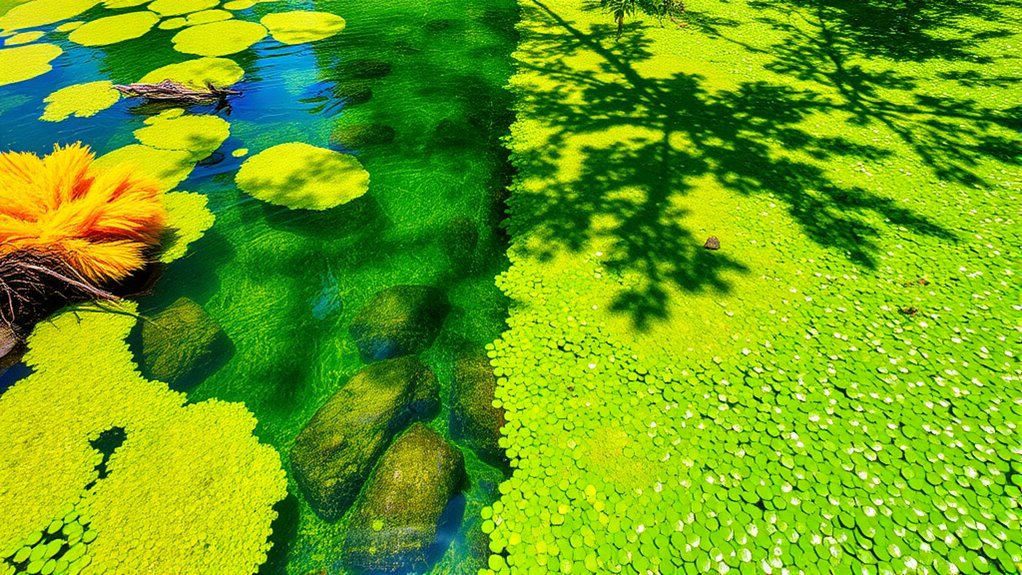
Sunlight and water conditions play a pivotal role in algae growth, as they directly influence how quickly algae can develop and spread. If your pond receives intense, direct sunlight for most of the day, it creates an ideal environment for algae to thrive. Excessive sunlight boosts photosynthesis, fueling algae proliferation. Similarly, water temperature matters; warmer water accelerates algae growth. Poor water circulation can lead to stagnant areas, allowing algae to settle and multiply. Nutrient-rich water, combined with ample sunlight and warmth, fuels algae blooms. Sticking wall decor to improve water circulation can help reduce algae growth. To control algae, you need to manage these conditions. Providing partial shade, improving water circulation, and reducing nutrient levels can markedly slow down algae growth. By understanding how sunlight and water conditions affect algae, you can take targeted steps to keep your pond clear.
How Algae Reproduce and Spread
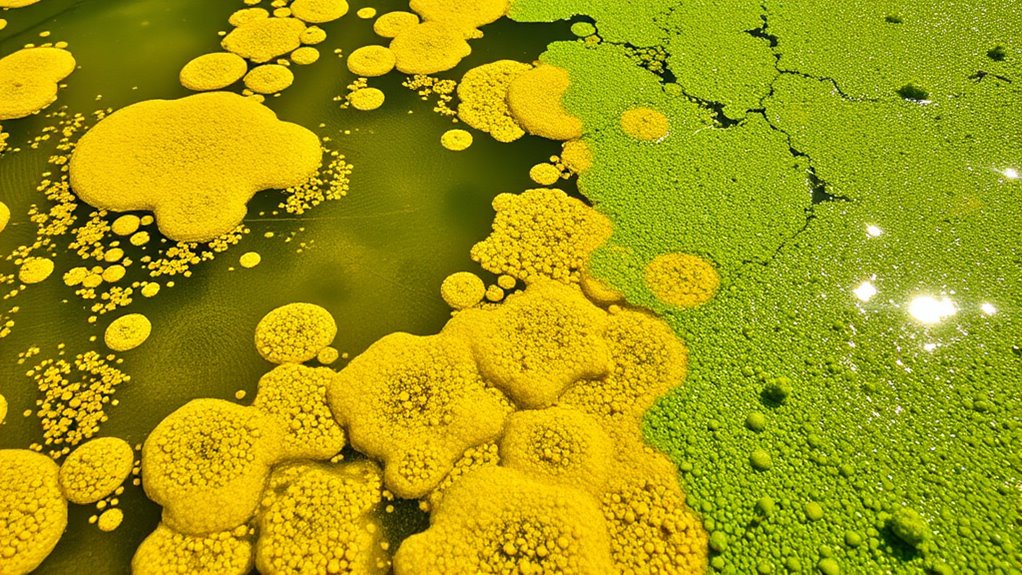
You might notice algae multiplying quickly in water, but do you know how they reproduce and spread? They use various methods, like releasing spores or dividing into new cells, to multiply efficiently. Water currents then carry these algae fragments to new areas, helping them spread even further.
Algal Reproduction Methods
Algal reproduction is a diverse and efficient process that allows these organisms to rapidly colonize new environments. You’ll find that many algae reproduce asexually through cell division, where a single cell splits into two, quickly increasing their numbers. Some species also reproduce via fragmentation, where parts of the algae break off and grow into new organisms. Others use spores—specialized reproductive cells that disperse easily and develop into new algae when conditions are right. These spores can be produced through various methods, like sporulation or cyst formation. Additionally, the presence of different reproductive strategies enables algae to adapt to changing conditions and outcompete other organisms. This versatility in reproduction methods is a key factor behind their widespread presence and ability to form dense colonies in aquatic environments.
Spread Through Water Currents
Algae rely heavily on water currents to disperse their reproductive cells and fragments, facilitating widespread colonization. When conditions are right, algae release spores or fragments that drift with the flow, reaching new areas quickly. Strong water movements can carry these reproductive units far from the original source, increasing the chances of establishing new colonies. This natural dispersal method allows algae to adapt to changing environments and recover after disturbances. If you notice algae spreading rapidly in a pond or aquarium, water currents are likely a key factor. Controlling flow rates or installing barriers can help limit their distribution. Understanding this spread mechanism is essential for effective algae management, as it highlights the importance of controlling water movement to prevent rapid and extensive algae growth. Incorporating water flow management techniques can significantly reduce algae proliferation and help maintain a healthy aquatic environment.
Causes Behind Algae Blooms in Water Features

Nutrient overloads, particularly excess nitrogen and phosphorus from runoff or decaying organic matter, often trigger algae blooms in water features. When these nutrients build up, they fuel rapid algae growth, obscuring water clarity and disrupting ecosystems. To understand the main causes, consider this table:
| Cause | Source | Effect |
|---|---|---|
| Excess nutrients | Runoff from fertilizers, decaying leaves | Accelerates algae growth |
| Poor filtration | Inadequate filtration system | Allows nutrient buildup |
| Sun exposure | Prolonged sunlight | Promotes algae proliferation |
| Stagnant water | Lack of circulation | Creates ideal environment for blooms |
| Organic debris | Dead plant matter | Adds nutrients to water |
Effective water circulation can help prevent stagnation and reduce algae blooms. Identifying these causes helps you target the real problems and prevent future algae outbreaks.
Effective Treatment Strategies for Mustard Algae
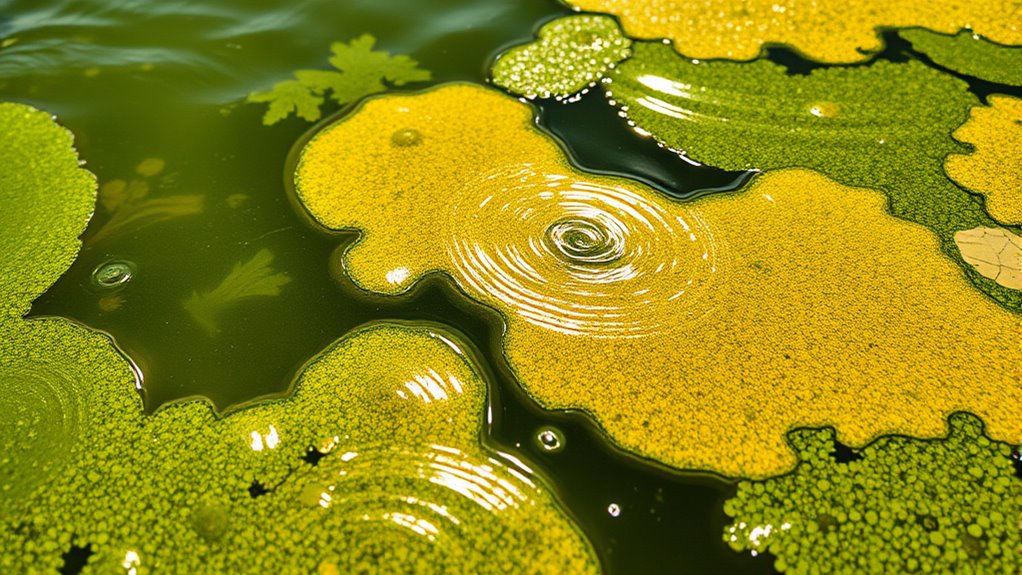
When dealing with mustard algae, applying targeted treatment methods can effectively eliminate it and prevent its return. Start by brushing the algae off surfaces to break its grip. Shock your water with a high dose of chlorine to kill remaining spores. Use a algaecide specifically formulated for mustard algae, ensuring proper dosage as per the manufacturer’s instructions. Maintain consistent sanitization and filtration to keep nutrients in check. Adjust pH levels if necessary, as mustard algae thrive in alkaline water. Regularly clean filters and remove debris to reduce organic matter that feeds algae growth. Consider adding a clarifier to improve water clarity. Monitoring water quality with testing kits helps identify nutrient levels that promote algae growth. Consistent maintenance and timely treatments are key to controlling mustard algae and keeping your water feature clear and healthy.
Best Practices for Preventing Green Algae Growth

You can keep green algae at bay by sticking to regular pool maintenance and cleaning. Ensuring proper water circulation prevents stagnation, while maintaining balanced chemical levels keeps algae from thriving. Additionally, inspecting and adjusting optimal angles for pinball machines can help maintain a balanced environment in your pool area, as proper setup minimizes vibrations and disturbances that could promote algae growth. By following these best practices, you’ll create an environment that discourages algae growth before it starts.
Regular Pool Maintenance
Regular pool maintenance is essential for preventing green algae growth and keeping your pool crystal clear. You should regularly test and balance your water’s pH, alkalinity, and sanitizer levels to create an environment that’s inhospitable for algae. Skim debris off the surface daily and brush the walls and floor weekly to remove algae spores before they settle. Keep your filter clean and running efficiently, as proper filtration removes algae and organic matter. Maintain a consistent chlorination schedule, especially during hot or high-traffic periods, to ensure continuous sanitizer presence. Regularly shock your pool if algae signs appear or after heavy use. By sticking to a routine, you’ll prevent algae buildup, reduce chemical costs, and enjoy a sparkling, healthy swimming environment. Speaks 4 Me Online
Proper Water Circulation
Proper water circulation is essential for preventing green algae growth because stagnant water creates ideal conditions for spores to settle and multiply. When water isn’t moving, nutrients and organic debris can accumulate, providing food for algae. To ensure proper circulation, run your pool’s pump daily for at least 8-12 hours, especially during peak sunlight and warm weather. Use strategically placed return jets to distribute water evenly throughout the pool. Regularly check and clean your pump, skimmer, and filter to maintain optimal flow. Avoid dead spots where water stagnates, as these areas are prime spots for algae to thrive. Proper circulation not only prevents algae growth but also improves overall water quality, clarity, and safety. Consistent movement keeps nutrients in suspension, making it harder for algae to establish.
Balanced Chemical Levels
Maintaining balanced chemical levels is essential for preventing green algae growth because imbalanced water chemistry creates favorable conditions for algae to thrive. You should regularly test your pool’s pH, alkalinity, and chlorine levels to guarantee they stay within ideal ranges. Aim for a pH of 7.2 to 7.6, as this helps chlorine work effectively and inhibits algae growth. Keep alkalinity stable between 80-120 ppm to buffer pH fluctuations. Maintain proper chlorine levels—ideally 1-3 ppm—to disinfect the water and prevent algae spores from taking hold. Avoid sudden chemical changes, and always add chemicals gradually. By consistently monitoring and adjusting these levels, you create an environment that’s less inviting for algae, keeping your pool clear and healthy. Additionally, understanding the chemical balance of your pool water can help prevent algae from developing in the first place.
Long-term Pond Maintenance to Control Algae
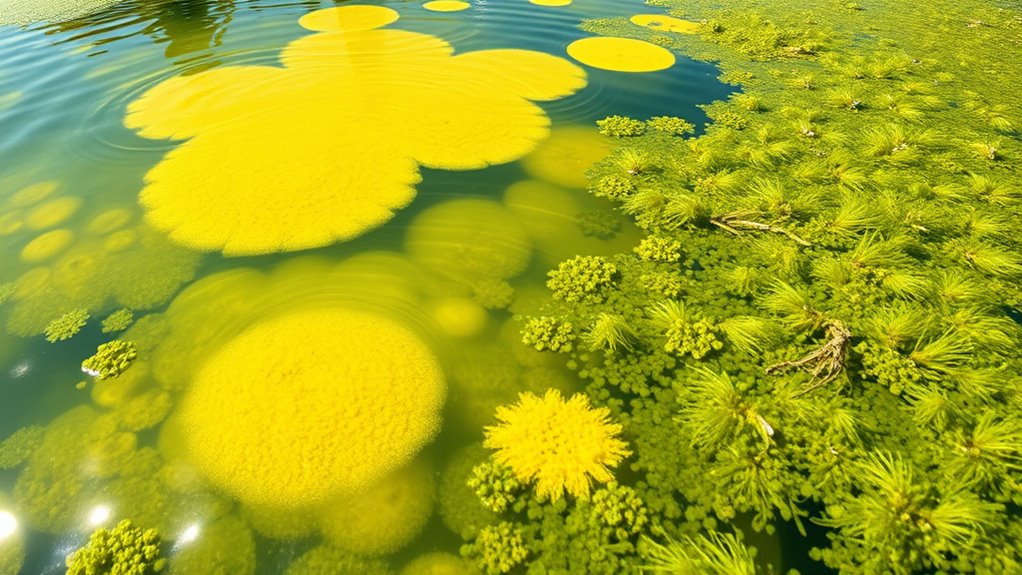
To effectively control algae in your pond over the long term, consistent maintenance practices are essential. First, you should regularly remove debris and excess organic matter, which feed algae growth. Second, guarantee your pond’s circulation is ideal by checking pumps and aerators—good flow discourages stagnant areas where algae thrive. Third, perform routine water testing to keep nutrient levels, like nitrates and phosphates, in check. Additionally, consider adding beneficial bacteria to naturally break down waste and reduce nutrient buildup. Maintaining a healthy balance prevents algae from taking over. By staying on top of these tasks, you create an environment less hospitable to algae, keeping your pond clearer and healthier for aquatic life. Consistent effort is key to long-term algae control.
When to Seek Professional Help for Severe Algae Issues

Severe algae outbreaks can quickly overwhelm your pond and threaten aquatic health, signaling that professional intervention may be necessary. If you notice persistent, extensive algae covering large areas, despite ongoing maintenance efforts, it’s time to call in experts. When algae blooms become stubborn, resistant to typical treatments, or recur rapidly after cleaning, DIY solutions might not suffice. Additionally, if algae are causing oxygen depletion, fish deaths, or foul odors, professional help becomes essential. Experts can diagnose underlying issues like nutrient overloads or water chemistry imbalances that contribute to severe problems. They have specialized tools and treatments that can safely and effectively restore your pond’s balance. Don’t delay seeking help if algae continue to escalate, as early intervention can save your pond’s health and prevent costly damage.
Frequently Asked Questions
Can Algae Types Harm Aquatic Life or Pond Ecosystems?
Yes, algae types can harm aquatic life and pond ecosystems. When algae overgrow, they deplete oxygen levels during decay, which can suffocate fish and other aquatic creatures. Some algae release toxins that are dangerous to wildlife and humans. Excessive algae also blocks sunlight, disrupting plant growth and overall pond health. You should regularly monitor and control algae to maintain a balanced and healthy aquatic environment.
Are There Natural Methods to Prevent Algae Growth?
Yes, natural methods can prevent algae growth. Imagine your pond as a balanced ecosystem: you can introduce aquatic plants like water lilies and submerged vegetation to compete with algae for nutrients, shade the water, and reduce sunlight exposure. Regularly removing debris and avoiding excess fertilizers also help. By maintaining healthy water conditions and encouraging natural plant growth, you create an environment less inviting for algae to thrive.
How Do Nutrient Levels Influence Algae Blooms?
Nutrient levels directly influence algae blooms because excess nutrients like phosphorus and nitrogen fuel algae growth. When you have high nutrient concentrations in your pond or pool, algae thrive and multiply rapidly. To prevent blooms, you should regularly test your water, limit fertilizer runoff, and maintain proper filtration. Reducing these nutrients cuts off algae food sources, helping keep your water clear and healthy.
What Are the Safest Chemical Treatments for Algae?
You should use algaecides containing copper or potassium permanganate, but always follow the manufacturer’s instructions carefully. These chemicals are effective at controlling algae growth while minimizing harm to your pool and environment. Consider using enzyme-based treatments or natural options like barley straw, which can help prevent algae without harsh chemicals. Regular brushing and filtration are essential to complement chemical treatments and keep your pool clear and healthy.
How Often Should Pond Maintenance Be Performed to Control Algae?
You should perform pond maintenance at least once a week to effectively control algae. Regularly skim debris, check water levels, and inspect filters. During warmer months, increase your efforts to twice a week, especially if algae blooms appear. Consistent maintenance helps prevent nutrient buildup and keeps your pond balanced. Stay vigilant, and address issues early to maintain clear, healthy water and avoid costly treatments later.
Conclusion
By understanding the subtle clues in color and texture, you become a skilled detective in your pond’s story. Spotting mustard versus green algae is like reading a map that guides you to the right fix, preventing a green, murky mess from taking over. With vigilant eyes and proper care, you can keep your pond’s crystal-clear reflection shining brightly, transforming it into a peaceful oasis where healthy aquatic life thrives like a vibrant underwater garden.
